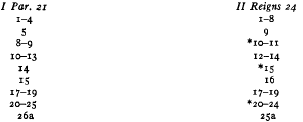Published online by Cambridge University Press: 10 June 2011
In composing his history of the monarchy the Chronicler incorporated material from the canonical Books of Samuel and Kings into his text. Although the Hebrew text of Chronicles in these parallel passages is not identical in every respect with the Hebrew text of Samuel and Kings, the correspondence of the two Hebrew texts is very close. Since the Greek translation of Samuel and Kings undoubtedly preceded that of Chronicles, the question arises whether the translator of Chronicles into Greek made use of the Greek translation of Samuel and Kings, and if so, in which text form or recension. The present investigation is confined to a comparative study of the synoptic parallels in the Greek texts of I Paraleipomena and I–II Reigns.
1 For a recent study of this problem that utilizes the new comparative material from Qumran, see Lemke, Werner E., The Synoptic Problem in the Chronicler's History, Harvard Theological Review 38 (1965), 349–63CrossRefGoogle Scholar.
2 See the detailed discussion of the recensional history of the Greek text for Reigns in Chapter One of the writer's monograph, Chronology and Recensional Development in the Greek Text of Kings (Cambridge: Harvard University Press, 1968)Google Scholar. For the sake of brevity the conclusions reached in this monograph together with the supporting evidence will not be repeated in the present paper.
3 These transpositions occur in I Paraleipomena 17:4, S, 18ter, 19, 22; 18:2, 8, 9, 10.
4 This hypothesis is both simpler and more in accord with what is now known of the recensional history of Reigns than the following explanation of Gerleman:
There can scarcely be any doubt that the correspondence in the wording of the Greek synoptic texts is largely due to a process of harmonization between them, similar to that of the synoptic gospels. This is borne out by an interesting observation that can be made in regard to the Greek synopsis. It will be found that the resemblance between the two Septuagint versions is more marked in the longer consecutive parallel texts, whereas the shorter and less striking parallel passages as a rule show greater discrepancies, often more so than in the corresponding passages in MT. The longer parallel texts have, in fact, been more exposed to assimilating influences, presenting natural friction surfaces, where “un-evennesses” have been filed away, so as to produce greater similarity with the parallel version. (Studies in the Septuagint II. Chronicles, Lunds Universitets Arsskrift. N.F. Avd. 1. Bd 43. Nr 3 [Lund, 1946], p. 37.)Google Scholar
5 In the synoptic passages see also: I Par. 13:9 = II Reigns 6:6; I Par. 14:9 = II Reigns 5:18; I Par. 15:29 = II Reigns 6:16; I Par. 18:5 = II Reigns 8:5; I Par. 19:2 = II Reigns 10:2; I Par. 19:15 = II Reigns 10:14; I Par. 19:17 = II Reigns 10:17.
6 See the writer, op. cit., Appendix B, where the evidence is presented to prove that the καιλε Recension begins at II Reigns 10:1.
7 Only the pertinent part of the respective Greek translations of the Hebrew cited is given here. Merely orthographic variants in the two Hebrew texts are ignored. Where the verses in the two chapters do not correspond, the verse number of R is given first, followed by that of P.
8 This is a characteristic translation of the καιλε Recension (see below).
9 This reading is also found in the minuscule manuscript j, where it is falsely attributed to Theodotion. The sixth column of the Hexapla for this section of II Reigns exhibits the Old Greek text form. See the writer, op. cit., Appendix B.
10 These are the only two instances in both Books of Paraleipomena where κþατειν is used to translate the verb, which occurs with comparatively high frequency. This clearly shows the dependence of P upon the Old Greek text form of Reigns.
11 See note 9.
12 See the writer, op. cit., Appendix A.
13 See Barthélemy, Dominique, Les Devanciers d'Aquila (Leiden, 1963), 63–65CrossRefGoogle Scholar.
14 Ibid., 31–47.
15 The synoptic passage I Par. 11:26–41 = II Reigns 23:24–39 is left out of consideration here because it contains proper names almost exclusively.
16 See the writer, op. cit., Appendix A.
17 Synoptic table of correspondences (an indicates that the correspondence of verses in P and R is only partial).

18 See Lemke, , op. cit., 355–57Google Scholar, for the citation of the reading from 4QSama and the discussion of the significance of this reading for evaluating the Hebrew text of Chronicles.
19 Barthelemy, , op, cit., 69–78Google Scholar.
20 Op. cit., 40, 23.
21 Op. cit., 78–80.
22 Ibid., 31–47.
23 Ibid., 59–60.
24 I bid., 69–78.
25 Op. cit., Appendix A.